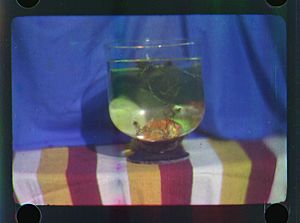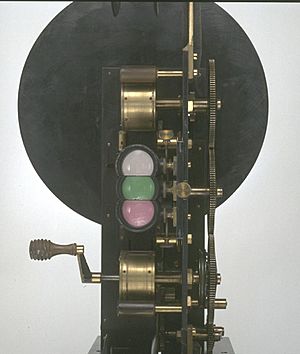Edward Raymond Turner facts for kids
Quick facts for kids
Edward Raymond Turner
|
|
|---|---|
 |
|
| Born | 1873 |
| Died | 9 March 1903 (aged 29–30) London, England
|
| Occupation | Film maker, inventor |
| Known for | producing the first color motion picture film |
Edward Raymond Turner (born 1873 – died March 9, 1903) was a British inventor and filmmaker. He was a pioneer in early cinema. He created the very first known color movie footage.
Contents
About Edward Raymond Turner
Edward Raymond Turner was born in 1873 in Clevedon, England. Later in his life, he lived in Hounslow, West London, with his wife Edith. Some of his early color film tests were done right in his backyard! These films showed his three young children: Alfred, Agnes, and Wilfrid.
Turner was only 29 years old when he died suddenly. He passed away on March 9, 1903, from a heart attack. This happened at his workshop in London. He was buried three days later in Heston, Hounslow. After his death, a film producer named Charles Urban took over his work. Urban had been helping Turner with money for his projects. He asked George Albert Smith to continue Turner's research.
Turner's Color Film Invention
Edward Turner is famous for trying to create the first real color movie system. He first got money from Frederick Marshall Lee. Later, Charles Urban helped him.
On March 22, 1899, Turner and Lee applied for a British patent. This was for a special 3-color movie process. It used an additive method to create colors. The patent was approved on March 3, 1900. In September 1902, Urban bought Lee's share. He kept funding Turner's work.
How Turner's Camera Worked
Turner's camera used a spinning disk with three different color filters. These filters were red, green, and blue. The camera would take pictures through these filters. It recorded the separate color images onto one roll of black-and-white film. Each picture on the film would have either a red, green, or blue filter applied.
How the Film Was Shown
When the film was finished, it was shown using a special projector. This projector also used the same red, green, and blue filters. It would project three film pictures at a time. Each picture went through its matching color filter. This was supposed to create a full-color image on the screen.
Challenges with the System
However, Turner's system had some problems. The colors didn't always line up perfectly.
- First, the three pictures for each color were not taken at the exact same moment. So, if something moved fast, it looked blurry. It also showed strange, false colors on the screen.
- Second, the machine itself wasn't very stable. This caused the three projected images to constantly shake and move around. They didn't stay perfectly on top of each other.
After Turner died in 1903, Charles Urban asked George Albert Smith to continue the project. Smith found Turner's system too difficult to make work well. Instead, Smith created a simpler two-color system called Kinemacolor. This system was quite successful for several years.
Turner's Lasting Impact
For a long time, people didn't fully realize how important Turner's work was. But in 2012, the UK's National Media Museum changed that. They used modern digital technology to combine his 110-year-old test films. They showed these restored films to the public on September 12, 2012.
Thanks to this modern digital restoration, we can now see his color films much better. The colors combine more successfully than they ever could with his original machines. This shows us just how ahead of his time Edward Turner truly was.
See also
- List of color film systems
- List of early color feature films
- List of film formats



